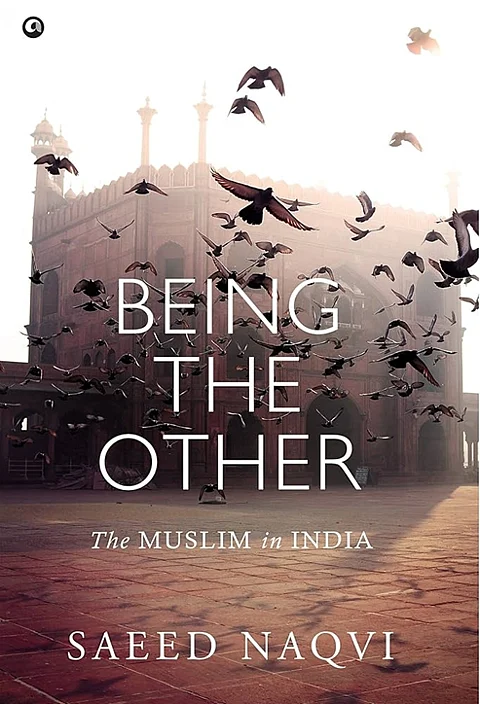

Shahruk Ahmed Mazumdar*
Being the Other Muslim in India is not a political history of Islam in India, nor does it purport to provide an exhaustive history of Muslims in India. Instead, it is a chronicle of Saeed Naqvi’s personal experience and views on significant moments in recent Indian history, as well as his growing disenchantment and unhappiness with the direction the nation is currently going. “The urge to write this book grew on me from the day… I drove from Lucknow to Ayodhya to witness shilanyas… of the Ram temple,” the author writes in the first chapter.
As he recounts his early years in Awadh, he continues, “In Awadh… the Shia liberal streak became the base on which a huge monument of multiculturalism was erected… Lucknow, the reservoir of composite culture was greatly augmented by Kashmiri Pandits too.”
As noted by Naqvi, “When the British wanted to annex Awadh, they realised that Wajid Ali Shah was much loved… an obstacle. He had to be removed… then exiled.” He goes on to say that historians largely disregarded his remarkable ruler, Wajid Ali Shah, and as a result, historical writings in the 1950s did not make much reference to his unique brilliance. The significance of the 1857 rebellion was emphasised by the author, who also noted that the insurrection served as the impetus for a national independence movement against the British.
Furthermore, it states, “In his famous speech… Disraeli described the annexation of Awadh as one of the principal causes of the uprising.” The author related his own experiences living in the MacDonnel Hostel at Aligarh Muslim University when he had to house three devout boys in a huge room. With their adherence to Tableeghi Jamaat, he discovered certain differences. Naqvi became conscious of his Shia lineage from that point on. It dawned on him that a Shia from Awadh was a category unto himself. The writer who recounts his upbringing says: “We were groomed into believing that Islam was the most dynamic of religions… it was Islam’s interaction with an older civilisation that resulted in Dara Shikoh, Rahim, Kabir, Amir Khusro, Ghalib, and Anis… and, sadly, this syncretism is now under siege.”
The British Raj purposefully incited Hindus against Muslims, establishing the foundations for their divide-and-rule doctrine. In Chapter 3, the author digs into theories that arose during and after the partition, such as who was responsible for the partition. Are there any other options available for Indian authorities to prevent similar massacres? Why was the country partitioned so quickly? Who mixed religion and politics?… What were Maulana Azad’s significant efforts to prevent partition? Finally, the author discusses the integration of Nizam-ruled Hyderabad into India as well as the issues that arose as a result.
In another chapter, the author discussed the controversies surrounding religious conversations. One event covered in the book is Meenakashipuram village in Tamil Nadu. And learn the facts about why such a conversion occurred. Is it a forced conversion, or do people choose to change to another religion?
In Chapter 5, Saeed Naqvi narrates the demolition of the Babri Masjid and the resulting rioting in various parts of the country. The politicisation of the entire process exacerbated this chaotic time. The failure of the then-UP government to maintain peace and order in the state. The question was addressed as to whether the centre did everything possible to avoid such a circumstance or whether they had any previous inputs, but their negligence could not avert this calamity.
In Chapter 6, the author discussed in great length the different riots that occurred at the time, including the Gujarat riots, Moradabad, Bhagalpur, Aligarh, Bombay, Faizabad, Muzaffarnagar riots, and several more. He also attempted to explain how and why communal riots occur, as well as what might be done to prevent them.
In Chapter 7, Naqvi uses reporting to observe all of the country’s leaders, primarily Indian Prime Ministers, their times, and the roles they played at the time. It covers the JP movement, Indira Gandhi’s emergency, her defeat in the 1977 election, Lal Bahadur Shastri’s tenure, the Tashkent Agreement, and other topics.
The author continues to write about the Kashmir issue and its problems with India and Pakistan during and after independence, and in the final chapter, he discusses the US declaration of war on terror and Ambassador Blackwill’s praise for Musharraf for joining the war on terror, as well as how it shapes a Muslim outlook in India and around the world.
It is a must-read for everyone who wants to understand the factors that influenced modern Indian society.
*The author is a writer and columnist, X/Twitter id: @Shahrukhahmedsk and can be contacted: shahruktechnical@gmail.com
—–
Have you liked the news article?